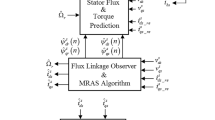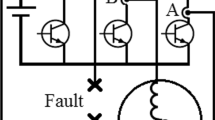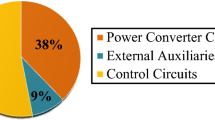Abstract
Current sensors are needed in conventional field-oriented control (FOC) in 3-phase induction motor (3-PIM) drives. Nevertheless, these sensors are exposed to different faults which reduce the reliability of drive systems. To solve this problem, a current sensor fault-tolerant control (FTC) for 3-PIM drives without speed measurement is proposed in this paper. In the proposed scheme, a sensorless FOC strategy based on open-loop speed estimator is utilized for normal condition. A third-difference operator performs the task of fault detection and isolation (FDI). After FDI, a sensorless FOC strategy based on extended Kalman filter (EKF) is used for the faulty condition. In this paper, the EKF is used for stator currents and speed estimation during post-fault operation. Such scheme is appropriate for sensorless 3-PIM drives to increase safety and reliability of the system, in the case of current sensor fault. The proposed FTC scheme is experimented for a 1HP 3-PIM drive system through a DSP/TMS320F28335. The experimental results show that the proposed FTC system can accurately and effectively control the 3-PIM during both healthy and faulty conditions.















Similar content being viewed by others
References
Hannan MA, Ali JA, Mohamed A, Hussain A (2018) Optimization techniques to enhance the performance of induction motor drives: a review. Renew Sustain Energy Rev 81:1611–1626
Jannati M, Anbaran SA, Asgari SH, Goh WY, Monadi A, Aziz MJA, Idris NRN (2017) A review on variable speed control techniques for efficient control of single-phase induction motors: evolution, classification, comparison. Renew Sustain Energy Rev 75:1306–1319
Bolognani S, Peretti L, Zigliotto M (2008) Parameter sensitivity analysis of an improved open-loop speed estimate for induction motor drives. IEEE Trans Power Electron 23(4):2127–2135
Rattanaudompisut A, Po-Ngam S (2015) Implementation of an adaptive full-order observer for speed-sensorless induction motor drives. In: 2015 18th international conference on electrical machines and systems (ICEMS). IEEE, pp 1871–1876
Bensiali N, Etien E, Benalia N (2015) Convergence analysis of back-EMF MRAS observers used in sensorless control of induction motor drives. Math Comput Simul 115:12–23
Zaky MS, Khater M, Yasin H, Shokralla SS (2010) Very low speed and zero speed estimations of sensorless induction motor drives. Electr Power Syst Res 80(2):143–151
Brandstetter P, Kuchar M (2017) Sensorless control of variable speed induction motor drive using RBF neural network. J Appl Logic 24:97–108
Yin Z, Li G, Zhang Y, Liu J (2018) Symmetric-strong-tracking-extended-Kalman-filter-based sensorless control of induction motor drives for modeling error reduction. IEEE Trans Industr Inf 15(2):650–662
Sun W, Xu DG, Jiang D (2018) Observability analysis for speed sensorless induction motor drives with and without virtual voltage injection. IEEE Trans Power Electron 34(9):9236–9246
Jannati M, Idris NRN, Aziz MJA (2016) Performance evaluation of the field-oriented control of star-connected 3-phase induction motor drives under stator winding open-circuit faults. J Power Electron 16(3):982–993
Niemann H, Stoustrup J (2005) Passive fault tolerant control of a double inverted pendulum—a case study. Control Eng Pract 13(8):1047–1059
Prieto IG, Duran MJ, Garcia-Entrambasaguas P, Bermudez M (2019) Field-oriented control of multiphase drives with passive fault tolerance. IEEE Trans Ind Electron 67(9):7228–7238
Benosman M, Lum KY (2009) Passive actuators’ fault-tolerant control for affine nonlinear systems. IEEE Trans Control Syst Technol 18(1):152–163
Raisemche A, Boukhnifer M, Larouci C, Diallo D (2013) Two active fault-tolerant control schemes of induction-motor drive in EV or HEV. IEEE Trans Veh Technol 63(1):19–29
Tabbache B, Rizoug N, Benbouzid MEH, Kheloui A (2012) A control reconfiguration strategy for post-sensor FTC in induction motor-based EVs. IEEE Trans Veh Technol 62(3):965–971
Xiahou KS, Wu QH (2018) Fault-tolerant control of doubly-fed induction generators under voltage and current sensor faults. Int J Electr Power Energy Syst 98:48–61
Sobanski P, Orlowska-Kowalska T (2017) Faults diagnosis and control in a low-cost fault-tolerant induction motor drive system. Math Comput Simul 131:217–233
González-Prieto I, Duran MJ, Rios-Garcia N, Barrero F, Martín C (2017) Open-switch fault detection in five-phase induction motor drives using model predictive control. IEEE Trans Ind Electron 65(4):3045–3055
Meinguet F, Sandulescu P, Kestelyn X, Semail E (2012) A method for fault detection and isolation based on the processing of multiple diagnostic indices: application to inverter faults in AC drives. IEEE Trans Veh Technol 62(3):995–1009
Hajary A, Kianinezhad R, Seifossadat SG, Mortazavi SS, Saffarian A (2019) Detection and localization of open-phase fault in three-phase induction motor drives using second order rotational park transformation. IEEE Trans Power Electron 34(11):11241–11252
Verucchi C, Bossio G, Bossio J, Acosta G (2016) Fault detection in gear box with induction motors: an experimental study. IEEE Latin Am Trans 14(6):2726–2731
Tousizadeh M, Che HS, Selvaraj J, Rahim NA, Ooi BT (2018) Performance comparison of fault-tolerant three-phase induction motor drives considering current and voltage limits. IEEE Trans Ind Electron 66(4):2639–2648
Rkhissi-Kammoun Y, Ghommam J, Boukhnifer M, Mnif F (2019) Two current sensor fault detection and isolation schemes for induction motor drives using algebraic estimation approach. Math Comput Simul 157:39–62
Gou B, Xu Y, Xia Y, Wilson G, Liu S (2018) An intelligent timeadaptive data-driven method for sensor fault diagnosis in induction motor drive system. IEEE Trans Ind Electron 66(12):9817–9827
Dominic DA, Chelliah TR (2014) Analysis of field-oriented controlled induction motor drives under sensor faults and an overview of sensorless schemes. ISA Trans 53(5):1680–1694
Yu Y, Zhao Y, Wang B, Huang X, Xu D (2017) Current sensor fault diagnosis and tolerant control for VSI-based induction motor drives. IEEE Trans Power Electron 33(5):4238–4248
Chakraborty C, Verma V (2014) Speed and current sensor fault detection and isolation technique for induction motor drive using axes transformation. IEEE Trans Ind Electron 62(3):1943–1954
Manohar M, Das S (2017) Current sensor fault-tolerant control for direct torque control of induction motor drive using flux-linkage observer. IEEE Trans Ind Inf 13(6):2824–2833
Zhang X, Foo G, Vilathgamuwa MD, Tseng KJ, Bhangu BS, Gajanayake C (2013) Sensor fault detection, isolation and system reconfiguration based on extended Kalman filter for induction motor drives. IET Electr Power Appl 7(7):607–617
Bernieri A, Betta G, Pietrosanto A, Sansone C (1994) A neural network approach to instrument fault detection and isolation. In: Conference proceedings. 10th Anniversary. IMTC/94. Advanced Technologies in I & M. 1994 IEEE Instrumentation and Measurement Technology Conference (Cat. No. 94CH3424-9). IEEE, pp 139–144
Betta G, Liguori C, Pietrosanto A (1998) An advanced neural-network-based instrument fault detection and isolation scheme. IEEE Trans Instrum Meas 47(2):507–512
Klimkowski K, Dybkowski M (2016) Neural network approach for stator current sensor fault detection and isolation for vector controlled induction motor drive. In: 2016 IEEE international power electronics and motion control conference (PEMC). IEEE, pp 1072–1078
Li H, Monti A, Ponci F (2012) A fuzzy-based sensor validation strategy for AC motor drives. IEEE Trans Ind Inf 8(4):839–848
Gaeta A, Scelba G, Consoli A (2012) Modeling and control of three-phase PMSMs under open-phase fault. IEEE Trans Ind Appl 49(1):74–83
Nikpayam M, Ghanbari M, Esmaeli A, Jannati M (2019) Fault-tolerant control of Y-connected three-phase induction motor drives without speed measurement. Measurement 149:1–14
Liu Y, Stettenbenz M, Bazzi AM (2018) Smooth fault-tolerant control of induction motor drives with sensor failures. IEEE Trans Power Electron 34(4):3544–3552
Benbouzid MEH, Diallo D, Zeraoulia M (2007) Advanced fault-tolerant control of induction-motor drives for EV/HEV traction applications: from conventional to modern and intelligent control techniques. IEEE Trans Veh Technol 56(2):519–528
Shi X, Krishnamurthy M (2014) Survivable operation of induction machine drives with smooth transition strategy for EV applications. IEEE J Emerg Sel Topics Power Electron 2(3):609–617
Krause PC, Wasynczuk O, Sudhoff SD, Pekarek S (2002) Analysis of electric machinery and drive systems, vol 2. IEEE Press, New York
Vas P (1998) Sensorless vector and direct torque control. Oxford University Press, Oxford
Bose BK (2002) Modern power electronics and AC drives, vol 123. Prentice hall, Upper Saddle River, NJ
Barut M, Bogosyan S, Gokasan M (2007) Speed-sensorless estimation for induction motors using extended Kalman filters. IEEE Trans Industr Electron 54(1):272–280
Author information
Authors and Affiliations
Corresponding author
Additional information
Publisher's Note
Springer Nature remains neutral with regard to jurisdictional claims in published maps and institutional affiliations.
Appendices
Appendix A
Parameters and nominal values of the 3-PIM
Stator resistance | Rotor resistance | Stator and rotor self-inductances | Mutual inductance | Number of pole pairs | Moment of inertia | Viscous friction coefficient | Nominal torque | Nominal voltage | Nominal power |
|---|---|---|---|---|---|---|---|---|---|
10.44Ω | 14.64Ω | 0.6067H | 0.597H | 2 | 0.016 kg.m2 | 0.001 N.m.s | 5.1 N.m | 400 V | 1HP |
Controller parameters
Speed PI controller | Current PI controller (d-axis) | Current PI controller (q-axis) | Reference rotor flux | Threshold |
|---|---|---|---|---|
\( \begin{aligned} K_{p} = 80\frac{A}{{\left( {{\text{rad}}/s} \right)}} \hfill \\ K_{i} = 120\frac{A}{{\left( {{\text{rad}}/s} \right)}} \hfill \\ \end{aligned} \) | \( \begin{aligned} K_{p} = 2\frac{V}{A} \hfill \\ K_{i} = 11\frac{V}{A} \hfill \\ \end{aligned} \) | \( \begin{aligned} K_{p} = 2\frac{V}{A} \hfill \\ K_{i} = 11\frac{V}{A} \hfill \\ \end{aligned} \) | 1wb | 0.7A |
Appendix B
The dq mutual fluxes can be expressed by (54) and (55) [28]:
Based on (30)–(33), (54), and (55), the following equations can be written:
The stator dq currents in terms of dq fluxes can be written as [28]:
Based on the 3-PIM model, (58), and (59), the rotor dq fluxes can be expressed by (60) and (61):
Finally, based on (56), (57), (60), (61), the following equations can be written:
Rights and permissions
About this article
Cite this article
Gholipour, A., Ghanbari, M., Alibeiki, E. et al. Speed sensorless fault-tolerant control of induction motor drives against current sensor fault. Electr Eng 103, 1493–1513 (2021). https://doi.org/10.1007/s00202-020-01179-0
Received:
Accepted:
Published:
Issue Date:
DOI: https://doi.org/10.1007/s00202-020-01179-0




